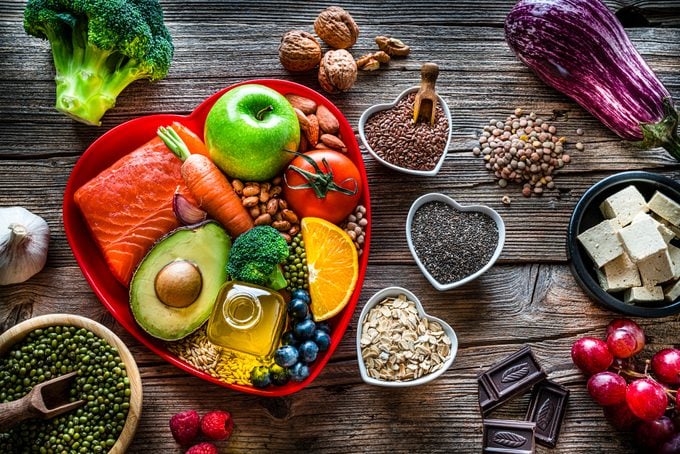8 Things You Can Do to Lower Your LDL Cholesterol
Updated: Sep. 07, 2021
Heart disease is a leading cause of death, and high cholesterol plays a big role. Here's how to lower your LDL cholesterol and keep your heart strong.
Go low for heart health
Cholesterol is an oily, waxy substance that’s a building block for many bodily processes. It serves as the backbone for certain hormones and helps repair cells in our tissues.
But there’s a catch. Our bodies need only a little bit of cholesterol for these housekeeping activities—and according to the Centers for Disease Control and Prevention (CDC), at least 38 percent of Americans have levels that are too high.
Excess blood levels of a specific type called low-density lipoprotein (LDL) is especially likely to wreak havoc. The more LDL cholesterol you have floating around in your bloodstream, the greater your risk for a heart attack or stroke.
The link is so strong that just a 10 percent decrease in total cholesterol levels (including LDL, which makes up most of the total cholesterol in your body) can reduce someone’s risk for heart disease by as much as 30 percent.
That’s why doctors want you to know how to lower LDL cholesterol and keep it at a healthy level.
What is LDL cholesterol?
Where does your blood cholesterol come from? It’s produced by the body’s liver.
Although you can also get cholesterol from animal-based foods, like eggs and meat, dietary cholesterol doesn’t play as big a role in your heart health as once thought. Other food components, like saturated fat, are more likely to cause the liver to produce cholesterol (more on that later).
Because cholesterol is a “waxy” fat and our blood is mostly water, they don’t mix. So our body shuttles it around with cholesterol-carrying molecules called lipoproteins.
The lipoprotein’s density helps determine the type of cholesterol. Considering fat is less dense than protein, the particles with a lot of fat are considered low-density lipoprotein, or “bad” cholesterol. On the flip side, high-density lipoprotein (HDL) has more protein than fat and is considered “good” cholesterol.
Once our body extracts what it needs from these molecules—like energy from triglycerides, another type of fat—what remains is leftover cholesterol floating around in our blood.
“They’re supposed to be cleared by our liver,” says cardiologist Donald Lloyd-Jones, MD, chair of preventive medicine at Northwestern University and the president of the American Heart Association.
But some of us are less efficient at clearing those particles from the bloodstream, and at higher levels, the LDL particles carrying cholesterol can start getting into our artery walls.
“That’s when they can cause trouble,” says Dr. Lloyd-Jones.
What happens when LDL cholesterol is too high?
When these LDL cholesterol particles get into our arteries, they trigger an immune system response. The body sends in inflammatory cells to try and clear the leftover cholesterol, but that very process creates more damage, which can attract more LDL cholesterol particles.
“It becomes a little bit of a vicious cycle,” Dr. Lloyd-Jones says.
He explains that over time, this damage can make it more likely someone will form plaque in their artery walls. That narrows the arteries, limiting blood flow and significantly raising the risk of heart disease.
HDL vs. LDL cholesterol
Cholesterol is cholesterol; it’s the type of particle carrying it that makes it “good” or “bad” for our body.
Whereas LDL particles tend to deliver excess cholesterol to our tissues and arteries, HDL particles are designed to help with the body’s cleanup process.
“The HDL [cholesterol] sort of functions like a vacuum cleaner,” explains Holly Ippisch, MD, a pediatric cardiologist at Cincinnati Children’s Hospital Medical Center. “It helps pick up the LDL and take it back to the liver, where the body can get rid of it or use it for other functions.”
What causes high LDL cholesterol?
High LDL cholesterol levels are primarily driven by poor dietary habits, explains Eugene Yang, chair of the American College of Cardiology’s Prevention of Cardiovascular Disease Section Leadership Council and professor at the University of Washington School of Medicine.
The Western diet—typically high in things like unhealthy saturated fats—encourages elevated LDL cholesterol levels.
With the increasing availability of fast and processed foods, high cholesterol is a trend that’s on the rise worldwide.
According to The New England Journal of Medicine, the number of deaths attributed to high LDL cholesterol grew by almost one million between 1990 and 2017. This research also shows a drastic shift in cholesterol-related death rates from high-income regions to middle- or low-income countries, particularly in Asia.
But diet isn’t the only culprit. Genetics can influence a person’s risk for having high LDL cholesterol—and the heart problems that can occur as a result.
Dr. Yang explains that about one in 250 people has what’s called familial hypercholesterolemia, a genetic mutation that affects their ability to clear LDL cholesterol from their body.
This predisposes people to levels of cholesterol that are higher than the average person. As a result, they’re up to 22 times more likely to have coronary heart disease, according to the CDC.
However, even if you don’t have familial hypercholesterolemia, other genetic factors can mean you are at greater risk for high cholesterol and heart trouble. The good news is that even if you are at higher risk due to genetics, making lifestyle changes like healthy eating and exercise can help.
A normal range for LDL cholesterol
Dr. Lloyd-Jones says that there are average cholesterol values people can shoot for, but in general, the most optimal range for an individual can vary from one person to the next.
Still, he says that if you’re a healthy adult with no family history of high cholesterol and no personal history of heart disease, good starting points are:
- Total cholesterol: less than 200 milligrams per deciliter of blood (mg/dl)
- LDL cholesterol: less than 130 mg/dl
- HDL cholesterol: 50 mg/dl or higher
- Triglycerides: less than 150 mg/dl—ideally below 100 mg/dl
“But if you have other risk factors, like smoking, high blood pressure, or diabetes, these [average] levels might be too high for you,” he explains. “It’s important to understand the context of your personal situation so that you and your doctor can decide the right numbers for you.”

How to lower LDL cholesterol levels
When we’re born, our genetic makeup sets a range around which our LDL cholesterol levels will orbit throughout our lives, says Dr. Lloyd-Jones.
Yet while we can’t control this genetic range, we can leverage factors like our diet, lifestyle, medications to keep cholesterol levels at the lowest—and healthiest—point in that predetermined spread.
Lower LDL cholesterol with diet and nutrition
According to experts, eating patterns have a big influence on the levels of LDL cholesterol in your body.
Although some people absorb dietary cholesterol into their bodies from food more easily than others—and therefore are more affected by that extra egg yolk in their omelet—doctors say that there are general dietary guidelines that help lower LDL cholesterol.
Eat less saturated fat
“The typical recommendations are to start with decreasing saturated fats,” Dr. Ippisch says. This type of fat is known to raise LDL cholesterol levels and is one of the worst foods for cholesterol.
Limiting saturated fat means making dietary choices like choosing:
- Lower-fat dairy
- Baked or grilled options instead of fried or greasy foods
- Fiber-rich foods, like whole fruits, vegetables, and whole grains
- Lean protein like fish and poultry
Avoid trans fats
There’s a good reason the Food and Drug Administration set a target for food manufacturers to remove partially hydrogenated oils from processed foods by 2020. These trans fats raise LDL cholesterol.
This type of fat used to be in many types of margarine, baked goods (think pies and cookies), doughnuts, pizza, and fried foods.
Although removed from many products, it’s a good idea to continue to steer clear of these fats. To do that, read nutrition labels and buy products with zero trans fat on the label and no partially hydrogenated oils in the ingredient list.
Eat more healthy fats
A study from the University of California-San Diego School of Medicine also shows that when healthy fats like olive and canola oils are included in this cholesterol-friendly diet, outcomes improve even more.
To add healthy monounsaturated and polyunsaturate fats to your diet, stock up on foods like:
- Avocado
- Olive, canola, peanut, and sesame oils
- Nuts and nut butters
- Seeds, like flax and pumpkin
- Fish
Eat more fiber
Soluble fiber—found in fruits and veggies, whole grains like oats, and legumes—is a heart-healthy choice. According to a 2019 analysis published in The Lancet, a higher intake of dietary fiber is associated with lower levels of total cholesterol.
Lower cholesterol with lifestyle changes
Don’t rely on diet alone to bring your LDL cholesterol down to a healthy level. Think of eating as just one aspect of your cholesterol-lowering plan. Then target necessary lifestyle changes.
Lose weight
One of the most important strategies for managing your cholesterol is to maintain a healthy weight.
A study published in Translational Behavioral Medicine found that overweight and obese adults who shed just 5 percent of their body weight reduced risk factors for cholesterol-related heart problems. And greater weight loss led to bigger improvements.
“If you’re actively gaining weight, the liver is often already packed with fat or cholesterol,” Dr. Lloyd-Jones explains.
That means it can’t clear much more cholesterol from the bloodstream, so there will be more LDL particles hanging out and causing trouble.
Stop smoking
Quitting smoking can also influence your cholesterol management. While smoking doesn’t have a strong link to LDL cholesterol, it does tend to suppress HDL cholesterol levels.
Smoking also worsens the damage LDL cholesterol can cause our arteries, further increasing someone’s risk of heart disease.
Create an exercise routine
If you’re overweight or obese, exercise may help you lose pounds, which will help improve your cholesterol levels. But keeping a regular fitness routine is a good idea even if you don’t need to lose weight.
Research has shown that exercise can reduce cholesterol levels. And according to a study published in the journal Sports Medicine, regular physical activity can raise HDL cholesterol levels.
Lower LDL cholesterol with medication
“The most important feature that determines our LDL levels is the activity of receptors in the liver that pull LDL particles out of the blood,” says Dr. Lloyd-Jones.
He explains that cholesterol medications enhance the activity of those receptors, so our bodies can get rid of LDL cholesterol much more efficiently. Dr. Ippisch adds that this class of drugs (called statins) also works to slow down how much cholesterol is being made in our liver.
“[Doctors] look at the overall risk of the patient to determine who might benefit from medication in addition to lifestyle changes to lower their LDL cholesterol,” Dr. Lloyd-Jones says.
Higher-risk individuals can include those who already have cardiovascular disease and those with a genetic predisposition to elevated LDL cholesterol levels. But doctors may also use medication to lower LDL levels in people with health conditions like kidney disease, diabetes, or high blood pressure.
Dr. Lloyd-Jones explains that while someone may fall in the average range for LDL cholesterol, a “normal” number might be too high, depending on their additional risk factors. Medication brings it down to lower, safer levels, so there’s no additional fuel for artery-clogging plaque.
The healthy cholesterol level for you
It’s important for people to understand that there’s no “normal” LDL cholesterol level. Dr. Lloyd-Jones.
Instead, he says, you should work with your doctor to identify the level that’s most optimal for you and form a plan to get there. That begins with a cholesterol test and a discussion of your risk factors.
And if you learn your number is too high? You have a lot of potential ways to bring it back down again.















